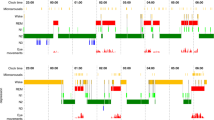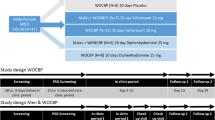Summary
The effect of a single dose (30 mg) of Org 3770 (metirzapine) on human sleep was assessed in a double blind, placebo controlled, cross over study in 6 young, healthy male volunteers. The sleep stage classification was based on visual scoring of 24 h electroencephalographic recordings according to the criteria of Rechtschaffen and Kales.
Org 3770 30 mg p.o. given 2 h before bedtime had a sleep promoting action in all subjects, resulting in a shortened time to the onset of sleep. Bedtime waking and dozing (Stage 1) were reduced in favour of deep, slow wave sleep (Stages 3 and 4). Org 3770 increased the latency of REM sleep with respect to Stage 2 sleep in all subjects. It also caused a minor reduction in waking periods during REM sleep and a lower frequency of awakenings after periods of movement. No effect of Org 3770 was observed in reaction and vigilance tests on the post treatment day.
The observed effects of Org 3770 on normal human sleep suggest that it might ameliorate the sleep disturbances encountered in endogenous depression, which are characterized by a reduction in slow wave sleep, an increase in nighttime awakenings and shortening of REM sleep latency.
Similar content being viewed by others
References
Claghorn JL, Johnstone EE, Studebaker SL, Ajeman SE (1987) The effectiveness of Org 3770 in depressed outpatients. Psychopharmacol Bull 23: 160–161
De Boer T, Maura G, Raiteri M, de Vos CJ, Wieringa JH, Pinder RM (1988) Neurochemical and autonomic pharmacological profiles of the 6-aza-analogue of mianserin, Org 3770 and its enantiomers. Neuropharmacol 27: 399–408
Fink M, Irwin P (1982) Pharmaco-EEG study of 6-azamianserin (Org 3770): Dissociation of EEG and pharmacologic predictors of antidepressant activity. Psychopharmacol 78: 44–48
Gillin JC, Borbely AA (1985) Sleep: a neurobiological window on affective disorders. TINS 1985: 537–542
Gillin JC, Sitarum N, Wehr T, Duncan W, Post RM, Murphy DL, Mendelson WB, Wyatt RJ and Bunney WE (1984) In: Post RM, Ballenger JC (eds) Neurobiology of mood disorders. Williams and Wilkins, Baltimore, pp 157–189
Idzikowski C, James R, Burton SW (1989) Human SWS is increased dose-dependantly by seganserin and ritanserin. Sleep Res 18: 55
Kemp B (1987) Model-based monitoring of human sleep stages. Thesis d.d. June 11, 1987. Technical University, Twente, The Netherlands
Kemp B, Kamphuisen AC (1986) Simulation of human hypnograms using a Markov chain model. Sleep 9: 405–414
Karczmar AG, Longo VG, Scott de Carolis (1970) A pharmacological model of paradoxical sleep: The role of cholinergic and monoaminergic systems. Physiol Behav 5: 175–182
Kupfer DJ (1976) REM latency, a psychobiological marker for primary depressive disease. Biol Psychiat 11: 159–174
McCarley RW, Hobson JA (1975) Neuronal excitability modulation over the sleep cycle: a structural and mathematical model. Science 189: 58–60
Nickolson VJ, Wieringa JH, van Delft AML (1982) Comparative pharmacology of mianserin, its main metabolites and 6-azamianserin. Naunyn Schmiedeberg's Arch Pharmacol 319: 48–53
O'Connor WT, Leonard BE (1986) Effect on chronic administration of the 6-aza analogue of mianserin (Org 3770) and its enantiomers on behaviour and changes in noradrenaline metabolism of olfactory-bulbectomised rats in the “open-field” apparatus. Neuropharmacol 25: 267–270
Ruigt GSF, van Loosbroek M, Ringens C, van Wezenbeek L (1988) Doserelated effects of mianserin treatment during the light and dark period on automatically classified rat sleep-waking behavior. In: Koella WP et al. (eds) Sleep '86. Fischer, Stuttgart, pp 329–332
Ruigt GSF, van Proosdij JN, van Delft AML (1989a) A large scale, high resolution, automated system for rat sleep staging, Part I: methodology and technical aspects. EEG Clin Neurophysiol 73: 52–63
Ruigt GSF, van Proosdij JN, van Wezenbeek LACM (1989b) A large scale, high resolution, automated system for rat sleep staging, Part II: validation and application. EEG Clin Neurophysiol 73: 64–71
Van Delft AML, Sitsen JMA, Ruigt GSF (1988) Antidepressant drugs can be differentiated by their effects on slow wave sleep in the rat. Psychopharm 965: 149
Van Sweden B, Kemp B, Kamphuisen HAC, van der Velde EA (1990) Alternative electrode placement in (automatic) sleep scoring (Fpz-Cz/Pz-Oz versus C4-A1).
Vogel GW (1983) Evidence for REM sleep deprivation as the mechanism of action of antidepressant drugs. Prog Neuropsychopharmacol Bull 7: 343–349
Vogel GW, Vogel F, McAbee RS and Thurmond AJ (1980) Improvement of depression by REM sleep deprivation; new findings and a theory. Arch Gen Psychiatry 37: 247–253
Author information
Authors and Affiliations
Rights and permissions
About this article
Cite this article
Ruigt, G.S.F., Kemp, B., Groenhout, C.M. et al. Effect of the antidepressant Org 3770 on human sleep. Eur J Clin Pharmacol 38, 551–554 (1990). https://doi.org/10.1007/BF00278580
Received:
Accepted:
Issue Date:
DOI: https://doi.org/10.1007/BF00278580




